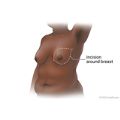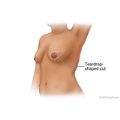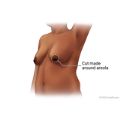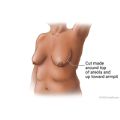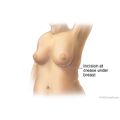Surgery Overview
Mastectomy is removal of the breast. Other nearby tissue may also be removed if it appears that cancer may have spread to these areas.
All mastectomies remove the whole breast. Because the size and location of tumors and where the cancer might have spread differ from one person to another, the amount of other tissue removed during surgery also varies.
Mastectomy procedures include:
- Total or simple mastectomy.
-
This is the removal of the whole breast.
- Modified radical mastectomy.
-
This is the removal of the whole breast and the lymph nodes under the arm (axillary lymph nodes).
- Radical mastectomy.
-
This is the removal of the breast, chest muscles, and all of the lymph nodes under the arm (axillary lymph node dissection). This surgery is rarely used now.
Male breast cancer is usually treated with one of the mastectomy procedures.
Depending on the location of the tumor in the breast or other factors, you may be able to have a skin-sparing or nipple-sparing mastectomy.
- Skin-sparing mastectomy leaves most of the skin that was over the breast, except for the nipple and the areola.
- Nipple-sparing mastectomy saves the skin over the breast as well as the nipple and areola.
If you'd like, you might choose to have breast reconstruction after a mastectomy. Reconstruction can be done during the same surgery as the mastectomy. Or it may be done later as a separate procedure.




